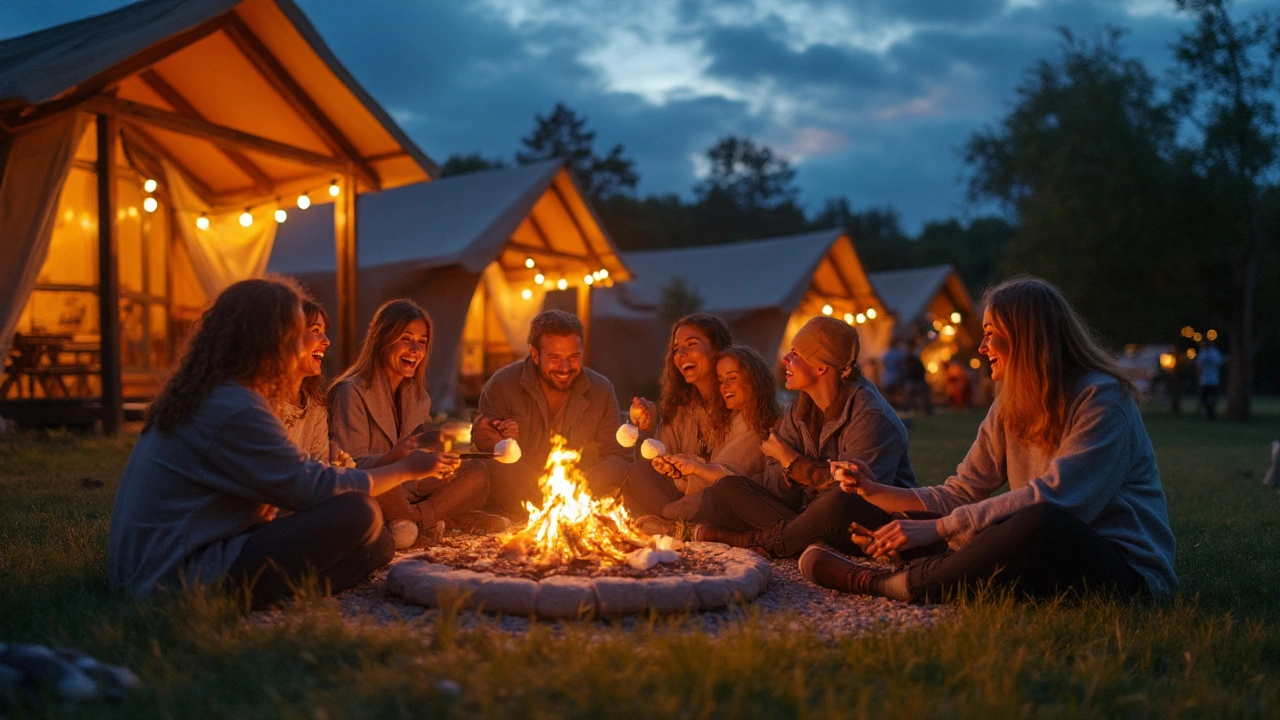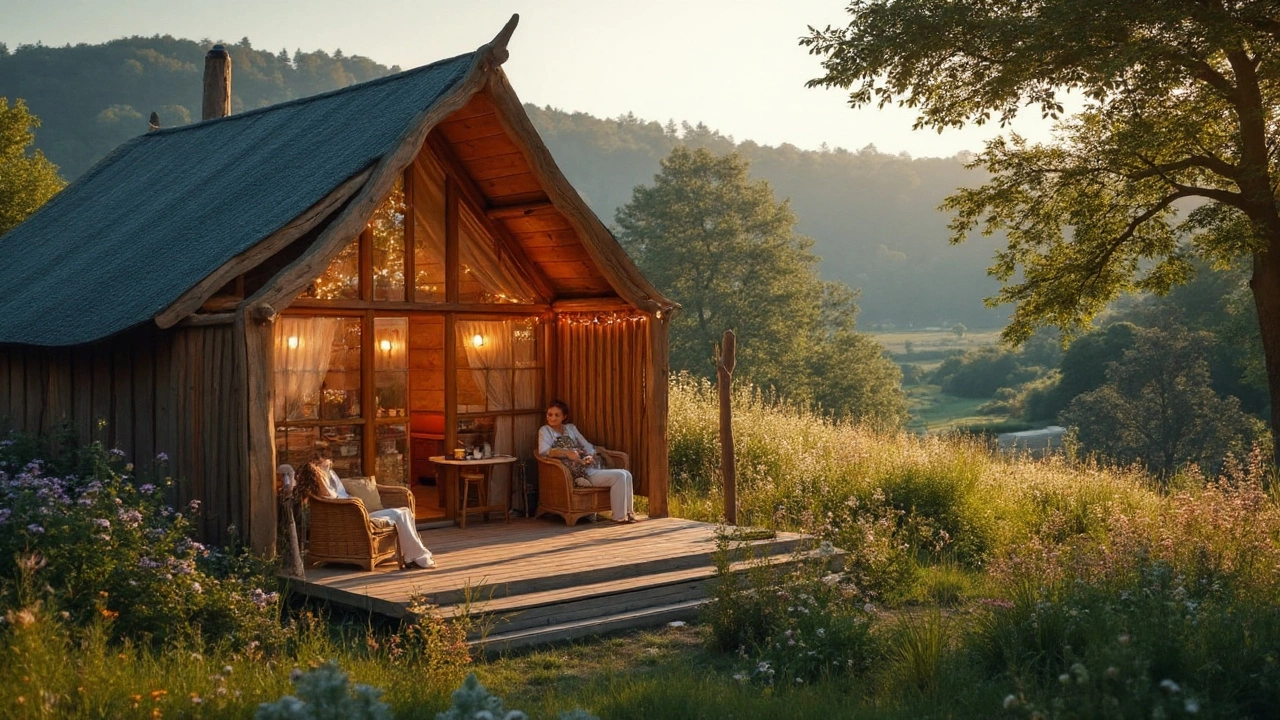Picture stepping out your door and being greeted by the chirping of birds, while your bed is just as plush as the one in any fancy hotel. That’s the vibe of a glamping cottage—it’s not just regular camping, and it’s not just a standard cottage either. Somehow, it manages to combine the charm of living close to nature with the perks of modern comfort. There’s something seriously alluring about waking up to wild views without sacrificing your hot shower or soft duvet. If you’re one of those people who loves the idea of the outdoors, but hates getting cramped in a tent or worrying about creepy crawlies, a glamping cottage might just be your perfect escape.
Defining the Glamping Cottage
So what actually is a glamping cottage? It’s clever, really. “Glamping”—a mashup of ‘glamorous’ and ‘camping’—captures the idea of spending time in the wild while enjoying real comfort. The glamping cottage spin brings a bit more: you’re not just getting a big tent with a cot, but a small, purpose-built house, often surrounded by stunning landscapes. These cottages come in all shapes and sizes, but they share a few things in common: heated bedrooms, proper bathrooms, and real beds are the baseline. Gone are the sleeping bags and portable toilets. Modern glamping cottages are typically designed with sustainability in mind. For example, many in New Zealand are powered by solar panels, built from locally sourced timber, and decked out with energy-efficient insulation. According to New Zealand’s Department of Conservation, eco-focused glamping sites have tripled in the last few years, helping reduce the tourism industry’s environmental impact. This combo of style, comfort, and eco-friendliness is why many people are swapping standard hotels for these tucked-away gems. But don’t think it’s all about luxury. Glamping cottages can be as simple or as upscale as you want. Fancy a hot tub under the stars? No problem. Prefer something more rustic, with little more than a fireplace and killer views? Totally doable. Some even include kitchenettes, meaning you can avoid sad campfire meals and whip up a feast if you feel like it.
What Sets Glamping Cottages Apart
You might wonder how glamping cottages stack up against other types of stays. One of the biggest draws is privacy—unlike busy campsites or crowded resorts, you often get the whole place to yourself. Many hosts in rural parts of New Zealand and beyond offer beautiful isolated plots, perfect if you’re looking to soak up nature without bumping elbows with the crowd. It’s easy to see the appeal: no noisy neighbours, no packed communal bathrooms, and no one judging you for sipping coffee in your pajamas on the porch. What about amenities? Expect the kind of conveniences you’d find at a boutique hotel, but surrounded by trees or mountains instead of city lights. Many glamping cottages offer free WiFi (yep, you can post all the wild snaps on social), cozy wood-burning stoves, rain showers, and even record players for retro music sessions. For the traveler who craves “something different,” it’s all about those thoughtful touches. Some hosts leave local produce or a bottle of wine—because what’s a nature break without a gourmet picnic? Kids and pets often get a warm welcome too, thanks to fenced yards and even sandboxes or swings. If you’re traveling with family, glamping cottages make it way easier to keep everyone happy. And holidaymakers chasing pet-friendly escapes are in luck; nearly half the glamping cottages on New Zealand’s major booking platforms allow furry friends.

Tasteful Designs and Unique Features
Get ready for some serious cottage envy. Glamping cottages come in so many styles, it’s easy to see why they’ve become something of a design trend. Some sit on raised platforms with glass walls overlooking a lake; others tuck into forests with wraparound decks and fairy lights. Tiny homes and A-frames are hugely popular, mainly because their quirky shapes make the experience feel extra special. Trust me, snapping a pic from a snug storybook cottage will upgrade anyone’s travel feed. It’s not all about looks, though. Many cottages use clever tricks to blend with the environment—think green roofs planted with wildflowers, reclaimed wood, and giant picture windows that let in loads of light. Fans of stargazing will love glamping cottages with skylights or outdoor fire pits, perfect for nightcaps under the Milky Way. Some cottages up the ante with hammocks, private barbecue pits, or even outdoor clawfoot baths—the ultimate luxury move after a long day’s hiking. Eco-details matter here, too. Composting toilets are common, as are rainwater harvest systems. In fact, a study from the University of Otago showed that eco-conscious travelers are willing to pay up to 25% more for cottages with sustainability certifications. So if you’ve always dreamed of staying off the grid, but didn’t know where to start, a glamping cottage checks those boxes without you needing to rough it.
Where To Find the Best Glamping Cottages
If you’ve made it this far, you’re probably itching to know where to book your stay. Here’s the trick: glamping cottages are popping up everywhere, but some regions are real hotspots. In New Zealand’s North Island, around Rotorua and the Coromandel Peninsula, you’ll find lakeside cottages with geothermal hot pools. Down south, in places like Wanaka and Fiordland, expect forest retreats with mountain backdrops straight out of a fantasy film. Even in Europe, areas like Tuscany and Provence have their own spin: think old stone sheds converted into dreamy retreats. Booking platforms like Canopy Camping, Glamping Hub, and Airbnb all host a growing selection, so you can scroll until you find your dream retreat (and yes, filters for pet-friendly and off-grid options actually work!) If you care about sustainability, check whether hosts display eco-certifications—groups like the Global Sustainable Tourism Council and Tourism Industry Aotearoa often highlight certified glamping stays on their websites. If you want to save a few bucks, here’s a tip: midweek stays or visiting off-peak seasons (spring and autumn in New Zealand, for example), usually means lower prices and emptier sites. Many hosts drop prices in September before summer crowds hit, and offer extras like free breakfast or kayak rental to sweeten the deal.

Tips for Planning the Perfect Glamping Cottage Getaway
First up, check what’s actually included. Some glamping cottages throw in everything—towels, kitchen basics, games, even a light breakfast. Others expect you to BYO, down to the tea bags. Always ask about heating or cooling, especially if you’re heading out in winter or the height of summer. A cozy wood-burner is bliss in August, but there’s nothing worse than shivering through the night because someone forgot the extra blankets. Pack for adventure, but think comfort too: gumboots for muddy tracks, a good book for lazy afternoons, and perhaps marshmallows for toasting. Download offline maps just in case (trust me, patchy rural wifi is real). If you’re in a remote spot, double-check whether your phone gets a signal, or better yet, embrace the digital detox and let folks know you’re off-grid. Bring food and drinks that make life easy—nobody wants to spend their vacation dicing onions in a tiny kitchen. A go-to tip: prep a one-pot meal or cheese board to share. And while you’re there, ditch the schedule. The magic of a glamping cottage is setting your own pace, sipping morning coffee to birdsong, getting lost on bush trails, and watching the sun go down with zero rush. So next time you hear the word ‘glamping cottage’, you’ll know it means more than just an upgraded tent—it’s the intersection of glamping cottage comfort, fresh air, and a little imagination. If city life’s got you frazzled, why not swap the noise for birds and unwind with a side of comfort? The best part is, you don’t have to rough it to reconnect with nature—you just have to pick your perfect cottage.
